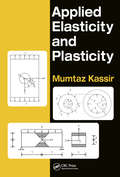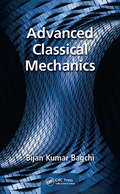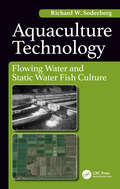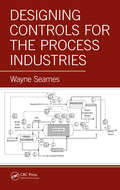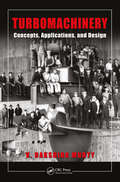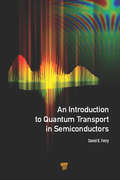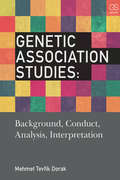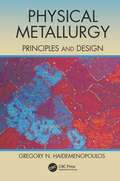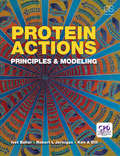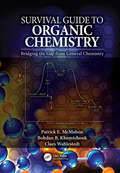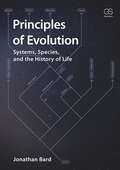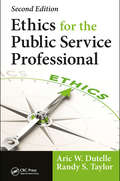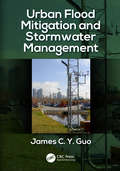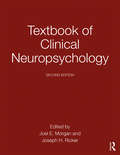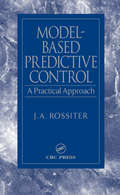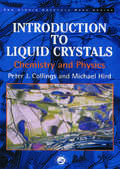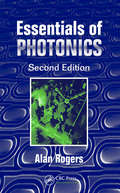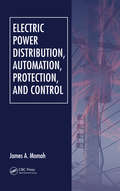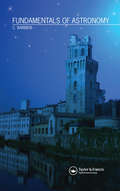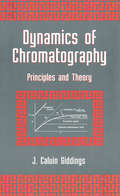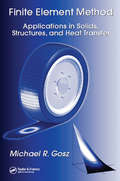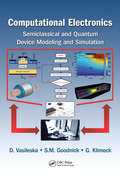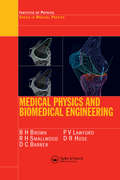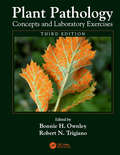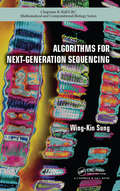- Table View
- List View
Applied Elasticity and Plasticity
by Mumtaz KassirApplied Elasticity and Plasticity is a comprehensive work that introduces graduate students and professionals in civil, mechanical, aeronautical and metallurgical engineering to the basic theories of elasticity, plasticity and their practical applications. Based on experimental data of static tension tests of material, several elastic and plastic stress-strain relations are derived, and commonly-used yield criteria and strain hardening rules are discussed as well. Analysis of conventional, deviatoric and mathematical stress and strain in two and three dimensions is presented. Analytical applications include torsion and bending of structural components subjected to various loadings, thick-walled cylindrical and spherical vessels subjected to internal and external pressures, stress-concentrations around holes, stress-intensity factors in structural components containing circular, elliptical and many more concepts important for professionals and students alike.
Advanced Classical Mechanics
by Bijan BagchiThis book is designed to serve as a textbook for postgraduates, researchers of applied mathematics, theoretical physics and students of engineering who need a good understanding of classical mechanics. In this book emphasis has been placed on the logical ordering of topics and appropriate formulation of the key mathematical equations with a view to imparting a clear idea of the basic tools of the subject and improving the problem solving skills of the students. The book provides a largely self-contained exposition to the topics with new ideas as a smooth continuation of the preceding ones. It is expected to give a systematic and comprehensive coverage of the methods of classical mechanics.
Aquaculture Technology: Flowing Water and Static Water Fish Culture
by Richard Soderberg W.Aquaculture Technology: Flowing Water and Static Water Fish Culture is the first book to provide the skills to raise fish in both a flowing water and a static water aquaculture system with a pragmatic and quantitative approach. Following in the tradition of the author’s highly praised book, Flowing Water Fish Culture, this work will stand out as one that makes the reader understand the theory of each type of aquaculture system; it will teach the user "how to think" rather than "what to think" about these systems. The book presents the scientific basis for the controlled husbandry of fish, whether it be in a stream of water or a standing water pool. Part 1, Flowing Water Fish Culture, is a major revision of the author’s initial book and includes greatly expanded coverage of rearing unit design criteria, fish growth and the use of liquid oxygen, hatchery effluent control, and recirculating systems. Part 2, Static Water Fish Culture, presents the scientific basis of fish culture in standing water systems including nutrient and dissolved gas dynamics, pond ecology, effects of fertilization and supplemental feeding, water quality management and representative static water aquacultures. Aquaculture Technology conveys the science in a manner appropriate for use by university students and teachers and others involved in fish production and aquaculture research and development worldwide. It will enable the reader to adapt to changing technologies, markets, and environmental regulations as they occur.
Designing Controls for the Process Industries
by Wayne SeamesOffering a modern, process-oriented approach emphasizing process control scheme development instead of extended coverage of LaPlace space descriptions of process dynamics, this text focuses on aspects that are most important for process engineering in the 21st century. Instead of starting with the controller, the book starts with the process and moves on to how basic regulatory control schemes can be designed to achieve the process’ objectives while maintaining stable operations. In addition to continuous control concepts, process and control system dynamics are embedded into the text with each new concept presented. The book also includes sections on batch and semi-batch processes and safety automation within each concept area. It discusses the four most common process control loops—feedback, feedforward, ratio, and cascade—and discusses application of these techniques for process control schemes for the most common types of unit operations. It also discusses more advanced and less commonly used regulatory control options such as override, allocation, and split range controllers, includes an introduction to higher level automation functions, and provides guidance for ways to increase the overall safety, stability, and efficiency for many process applications. It introduces the theory behind the most common types of controllers used in the process industries and also provides various additional plant automation-related subjects.
Turbomachinery: Concepts, Applications, and Design
by V. Dakshina MurtyTurbomachinery: Concepts, Applications, and Design is an introductory turbomachinery textbook aimed at seniors and first year graduate students, giving balanced treatment of both the concepts and design aspects of turbomachinery, based on sound analysis and a strong theoretical foundation. The text has three sections, Basic Concepts, Incompressible Fluid Machines; and Compressible Fluid Machines. Emphasis is on straightforward presentation of key concepts and applications, with numerous examples and problems that clearly link theory and practice over a wide range of engineering areas. Problem solutions and figure slides are available for instructors adopting the text for their classes.
An Introduction to Quantum Transport in Semiconductors
by David K. FerryThroughout their college career, most engineering students have done problems and studies that are basically situated in the classical world. Some may have taken quantum mechanics as their chosen field of study. This book moves beyond the basics to highlight the full quantum mechanical nature of the transport of carriers through nanoelectronic structures. The book is unique in that addresses quantum transport only in the materials that are of interest to microelectronics—semiconductors, with their variable densities and effective masses. The author develops Green’s functions starting from equilibrium Green’s functions and going through modern time-dependent approaches to non-equilibrium Green’s functions, introduces relativistic bands for graphene and topological insulators and discusses the quantum transport changes that these bands induce, and discusses applications such as weak localization and phase breaking processes, resonant tunneling diodes, single-electron tunneling, and entanglement. Furthermore, he also explains modern ensemble Monte Carlo approaches to simulation of various approaches to quantum transport and the hydrodynamic approaches to quantum transport. All in all, the book describes all approaches to quantum transport in semiconductors, thus becoming an essential textbook for advanced graduate students in electrical engineering or physics.
Genetic Association Studies: Background, Conduct, Analysis, Interpretation
by Mehmet Tevfik DorakGenetic Association Studies is designed for students of public health, epidemiology, and the health sciecnes, covering the main principles of molecular genetics, population genetics, medical genetics, epidemiology and statistics. It presents a balanced view of genetic associations with coverage of candidate gene studies as well as genome-wide association studies. All aspects of a genetic association study are included, from the lab to analysis and interpretation of results, but also bioinformatics approaches to causality assessment. The role of the environment in genetic disease is also highlighted. Genetic Association Studies will enable readers to understand and critique genetic association studies and set them on the way to designing, executing, analyzing, interpreting, and reporting their own.
Physical Metallurgy: Principles and Design
by Gregory N. HaidemenopoulosPhysical metallurgy is one of the main fields of metallurgical science dealing with the development of the microstructure of metals in order to achieve desirable properties required in technological applications. Physical Metallurgy: Principles and Design focuses on the processing–structure–properties triangle as it applies to metals and alloys. It introduces the fundamental principles of physical metallurgy and the design methodologies for alloys and processing. The first part of the book discusses the structure and change of structure through phase transformations. The latter part of the books deals with plastic deformation, strengthening mechanisms, and mechanical properties as they relate to structure. The book also includes a chapter on physical metallurgy of steels and concludes by discussing the computational tools, involving computational thermodynamics and kinetics, to perform alloy and process design.
Protein Actions: Principles and Modeling
by Ken Dill Robert L. Jernigan Ivet BaharProtein Actions: Principles and Modeling is aimed at graduates, advanced undergraduates, and any professional who seeks an introduction to the biological, chemical, and physical properties of proteins. Broadly accessible to biophysicists and biochemists, it will be particularly useful to student and professional structural biologists and molecular biophysicists, bioinformaticians and computational biologists, biological chemists (particularly drug designers) and molecular bioengineers. The book begins by introducing the basic principles of protein structure and function. Some readers will be familiar with aspects of this, but the authors build up a more quantitative approach than their competitors. Emphasizing concepts and theory rather than experimental techniques, the book shows how proteins can be analyzed using the disciplines of elementary statistical mechanics, energetics, and kinetics. These chapters illuminate how proteins attain biologically active states and the properties of those states. The book ends with a synopsis the roles of computational biology and bioinformatics in protein science.
Survival Guide to Organic Chemistry: Bridging the Gap from General Chemistry
by Patrick E. McMahon Bohdan B. Khomtchouk Claes WahlestedtThe Survival Guide to Organic Chemistry: Bridging the Gap from General Chemistry enables organic chemistry students to bridge the gap between general chemistry and organic chemistry. It makes sense of the myriad of in-depth concepts of organic chemistry, without overwhelming them in the necessary detail often given in a complete organic chemistry text. Here, the topics covered span the entire standard organic chemistry curriculum. The authors describe subjects which require further explanation, offer alternate viewpoints for understanding and provide hands-on practical problems and solutions to help master the material. This text ultimately allows students to apply key ideas from their general chemistry curriculum to key concepts in organic chemistry.
Principles of Evolution: Systems, Species, and the History of Life
by Jonathan BardPrinciples of Evolution covers all aspects of the subject. Following an introductory section that provides necessary background, it has chapters on the evidence for evolution that cover the fossil record, DNA-sequence homologies, and protein homologies (evo-devo). It also includes a full history of life from the first universal common ancestor, through the rise of the eukaryote and on to the major groups of phyla. This section is followed by one on the mechanism of evolution with chapters on variation, selection and speciation. The main part of the book ends with a chapter on human evolution and this is followed by appendices that expand on the making of fossils, the history of the subject and creationism. What marks this book as different from others on evolution is its systems-biology perspective. This new area focuses on the role of protein networks and on multi-level complexity, and is used in three contexts. First, most biological activity is driven by such networks and this has direct implications for understanding evo-devo and for seeing how variation is initiated, mainly during embryogenesis. Second, it provides the natural language for discussing phylogenetics. Third, evolutionary change involves events at levels ranging from the genome to the ecosystem and systems biology provides a context for integrating material of this complexity. The book assumes a basic grounding in biology but little mathematics as the difficult subject of evolutionary population genetics is mainly covered qualitatively, with major results being discussed and used rather than derived. Principles of Evolution will be an interesting and thought-provoking text for undergraduates and graduates across the biological sciences.
Ethics for the Public Service Professional
by Aric W. Dutelle Randy S. TaylorHeadlines of public service corruption scandals are painful reminders of the need for continuing education in the subjects of ethics and integrity. Public service professionals employed as government officials, forensic scientists, investigators, first responders, and those within the legal and justice systems, face daily decisions that can mean the difference between life or death and freedom or imprisonment. Sometimes, such decisions can present ethical dilemmas even to the most seasoned of professionals. Building on the success of the first edition, Ethics for the Public Service Professional, Second Edition serves as a single-source resource for the topic of ethics and ethical decision making as it relates to government service. While incorporating an examination of the history of ethics, codes and legislation, the book exposes the reader to the challenges faced by today’s public service professionals and administrators in incorporating ethics within daily decisions, procedures, and duties. Key features include: Current controversies in police, forensic, and other public service sectors including: racial profiling, evidence tampering, disaster response, and audits Important new mechanisms of accountability, including use-of-force reporting, citizen complaint procedures, and open government Contemporary news stories throughout the book introduce the reader to a broad range of ethical issues facing leaders within the public service workplace Chapter pedagogy including key terms, learning objectives, end-of-chapter questions, a variety of boxed ethical case examples, and references Ripped from the Headlines current event examples demonstrate actual scenarios involving the issues discussed within each chapter This in-depth text will be essential for the foundational development and explanation of protocols used within a successful organization. As such, Ethics for the Public Service Professional, Second Edition will help introduce ethics and ethical decision-making to both those new to the realm of forensic science, criminal justice, and emergency services and those already working in the field.
Urban Flood Mitigation and Stormwater Management
by James C GuoEffective urban drainage to manage stormwater and control flooding depends on good engineering, especially when an environmentally sustainable approach is being applied. This new text focuses on green methods and modelling techniques. It covers the principles of hydrology and drainage, low-impact-development (LID) designs, computer modelling techniques, the evaluation of existing systems, and planning for both new development and urban renewal. It outlines design procedures using examples, spreadsheet models, photos, and real-world design examples. Unlike other books, which focus on extreme events, this book covers hydrologic designs for both extreme and frequent events, and reflects the latest revolution in stormwater LID management, and takes a quantitative as well as a qualitative approach. PowerPoint® presentations and Excel® computer models are provided to follow and build on the exercises in the book. It is written especially for students on urban watershed courses, and also for those studying urban planning, landscaping, water resources, hydrology and hydraulics.
Textbook of Clinical Neuropsychology
by Joel E. Morgan Joseph H. RickerThe first edition of the Textbook of Clinical Neuropsychology set a new standard in the field in its scope, breadth, and scholarship. The second edition comprises authoritative chapters that will both enlighten and challenge readers from across allied fields of neuroscience, whether novice, mid-level, or senior-level professionals. It will familiarize the young trainee through to the accomplished professional with fundamentals of the science of neuropsychology and its vast body of research, considering the field’s historical underpinnings, its evolving practice and research methods, the application of science to informed practice, and recent developments and relevant cutting edge work. Its precise commentary recognizes obstacles that remain in our clinical and research endeavors and emphasizes the prolific innovations in interventional techniques that serve the field’s ultimate aim: to better understand brain-behavior relationships and facilitate adaptive functional competence in patients. The second edition contains 50 new and completely revised chapters written by some of the profession's most recognized and prominent scholar-clinicians, broadening the scope of coverage of the ever expanding field of neuropsychology and its relationship to related neuroscience and psychological practice domains. It is a natural evolution of what has become a comprehensive reference textbook for neuropsychology practitioners.
Model-Based Predictive Control: A Practical Approach (Control Series)
by J. A. RossiterModel Predictive Control (MPC) has become a widely used methodology across all engineering disciplines, yet there are few books which study this approach. Until now, no book has addressed in detail all key issues in the field including apriori stability and robust stability results. Engineers and MPC researchers now have a volume that provides a complete overview of the theory and practice of MPC as it relates to process and control engineering.Model-Based Predictive Control, A Practical Approach, analyzes predictive control from its base mathematical foundation, but delivers the subject matter in a readable, intuitive style. The author writes in layman's terms, avoiding jargon and using a style that relies upon personal insight into practical applications.This detailed introduction to predictive control introduces basic MPC concepts and demonstrates how they are applied in the design and control of systems, experiments, and industrial processes. The text outlines how to model, provide robustness, handle constraints, ensure feasibility, and guarantee stability. It also details options in regard to algorithms, models, and complexity vs. performance issues.
Introduction to Liquid Crystals: Chemistry and Physics (Liquid Crystals Book Series)
by Peter J. Collings Michael HirdThis text relies on only introductory level physics and chemistry as the foundation for understanding liquid crystal science. Liquid crystals combine the material properties of solids with the flow properties of fluids. As such they have provided the foundation for a revolution in low- power, flat-panel display technology LCDs. In this book, the essential elements of liquid crystal science are introduced and explained from the perspectives of both the chemist and the physicist.; The text begins with an historical account of the discovery of liquid crystals and continues with a description of how different phases are generated and how different molecular architectures affect liquid crystalline properties. The rest of the book is concerned with understanding and explaining the properties of the various types of liquid crystals, and in the final part of the book, the technology of LCDs is discussed and illustrated.
Essentials of Photonics
by Alan RogersThe importance of photonics in science and engineering is widely recognized and will continue to increase through the foreseeable future. In particular, applications in telecommunications, medicine, astronomy, industrial sensing, optical computing and signal processing continue to become more diverse. Essentials of Photonics, Second Edition describes the entire range of photonic principles and techniques in detail. Previously named Essentials of Optoelectronics, this newly named second edition of a bestseller felects changes that have occurred in this field. The book presents a new approach that concentrates on the physical principbestles, demonstrating their interdependence, and developing them to explain more complex phenomena. It gives insight into the underlying physical processes in a way that is readable and easy to follow, as well as entirely self-contained. Written by an author with many years of experience in teaching and research, this book includes a detailed treatment of lasers, waveguides (including optical fibres), modulators, detectors, non-linear optics and optical signal processing. This new edition is brought up-to-date with additional sections on photonic crystal fibres, distributed optical-fibre sensing, and the latest developments in optical-fibre communications.
Electric Power Distribution, Automation, Protection, and Control
by James A. MomohNew methods for automation and intelligent systems applications, new trends in telecommunications, and a recent focus on renewable energy are reshaping the educational landscape of today's power engineer. Providing a modern and practical vehicle to help students navigate this dynamic terrain, Electric Power Distribution, Automation, Protection, and Control infuses new directions in computation, automation, and control into classical topics in electric power distribution.Ideal for a one-semester course for senior undergraduates or first-year graduate students, this text works systematically through basic distribution principles, renewable energy sources, computational tools and techniques, reliability, maintenance, distribution automation, and telecommunications. Numerous examples, problems, and case studies offer practical insight into the concepts and help build a working knowledge of protection schemes, fault analysis and synthesis, reliability analysis, intelligent automation systems, distribution management systems, and distribution system communications. The author details different renewable energy sources and teaches students how to evaluate them in terms of size, cost, and performance.Guided firmly by the author's wealth of industrial and academic experience, your students will learn the tools and techniques used to design, build, and operate future generations of distribution systems with unparalleled efficiency, robustness, and sustainability.
Fundamentals of Astronomy
by C BarbieriProviding a broad overview of foundational concepts, Fundamentals of Astronomy covers topics ranging from spherical astronomy to celestial mechanics, closing with two chapters that discuss elements of astronomical photometry and spectroscopy. Supplementary and explanatory notes at the end of each chapter provide references to material published in scientific journals, and solved and unsolved exercises allow students to review their understanding of the material. Broad in coverage, the book presents arguments from classical astronomy, such as spherical astronomy, that form the foundation for future work in the field. Features
Dynamics of Chromatography: Principles and Theory (Chromatographic Science Series)
by J. Calvin GiddingsThis classic and bestselling landmark publication, originally published in 1965, examines the dynamic mechanisms, fundamental principles, and physical properties of various chromatographic procedures. It offers methods to characterize, identify, and predict chromatographic phenomena - providing strategies to select the most appropriate separation tools and techniques for specific applications in chemistry, physics, biology, and forensic and environmental science.Written by a world-renowned pioneer in the field, Dynamics of Chromatography contains many worked equations and real-world examples in gas and liquid chromatography. It includes numerous schematic figures for visualization of key concepts, introduces the means to control migration rate differences and zone spreading, and presents a detailed random-walk model for clarification of column processes. It also analyzes flow, diffusion, and kinetic events, stresses the link between theory and practice, and summarizes mathematical quantities and parameters.
Finite Element Method: Applications in Solids, Structures, and Heat Transfer (Mechanical Engineering)
by Michael R. GoszThe finite element method (FEM) is the dominant tool for numerical analysis in engineering, yet many engineers apply it without fully understanding all the principles. Learning the method can be challenging, but Mike Gosz has condensed the basic mathematics, concepts, and applications into a simple and easy-to-understand reference.Finite Element Method: Applications in Solids, Structures, and Heat Transfer navigates through linear, linear dynamic, and nonlinear finite elements with an emphasis on building confidence and familiarity with the method, not just the procedures. This book demystifies the assumptions made, the boundary conditions chosen, and whether or not proper failure criteria are used. It reviews the basic math underlying FEM, including matrix algebra, the Taylor series expansion and divergence theorem, vectors, tensors, and mechanics of continuous media.The author discusses applications to problems in solid mechanics, the steady-state heat equation, continuum and structural finite elements, linear transient analysis, small-strain plasticity, and geometrically nonlinear problems. He illustrates the material with 10 case studies, which define the problem, consider appropriate solution strategies, and warn against common pitfalls. Additionally, 35 interactive virtual reality modeling language files are available for download from the CRC Web site.For anyone first studying FEM or for those who simply wish to deepen their understanding, Finite Element Method: Applications in Solids, Structures, and Heat Transfer is the perfect resource.
Computational Electronics: Semiclassical and Quantum Device Modeling and Simulation
by Stephen M. Goodnick Dragica Vasileska Gerhard KlimeckStarting with the simplest semiclassical approaches and ending with the description of complex fully quantum-mechanical methods for quantum transport analysis of state-of-the-art devices, Computational Electronics: Semiclassical and Quantum Device Modeling and Simulation provides a comprehensive overview of the essential techniques and methods for effectively analyzing transport in semiconductor devices. With the transistor reaching its limits and new device designs and paradigms of operation being explored, this timely resource delivers the simulation methods needed to properly model state-of-the-art nanoscale devices. The first part examines semiclassical transport methods, including drift-diffusion, hydrodynamic, and Monte Carlo methods for solving the Boltzmann transport equation. Details regarding numerical implementation and sample codes are provided as templates for sophisticated simulation software. The second part introduces the density gradient method, quantum hydrodynamics, and the concept of effective potentials used to account for quantum-mechanical space quantization effects in particle-based simulators. Highlighting the need for quantum transport approaches, it describes various quantum effects that appear in current and future devices being mass-produced or fabricated as a proof of concept. In this context, it introduces the concept of effective potential used to approximately include quantum-mechanical space-quantization effects within the semiclassical particle-based device simulation scheme. Addressing the practical aspects of computational electronics, this authoritative resource concludes by addressing some of the open questions related to quantum transport not covered in most books. Complete with self-study problems and numerous examples throughout, this book supplies readers with the practical understanding required to create their own simulators.
Medical Physics and Biomedical Engineering (Series in Medical Physics and Biomedical Engineering)
by B. H Brown R. H Smallwood D. C. Barber P. V Lawford D. R HoseMedical Physics and Biomedical Engineering provides broad coverage appropriate for senior undergraduates and graduates in medical physics and biomedical engineering. Divided into two parts, the first part presents the underlying physics, electronics, anatomy, and physiology and the second part addresses practical applications. The structured approach means that later chapters build and broaden the material introduced in the opening chapters; for example, students can read chapters covering the introductory science of an area and then study the practical application of the topic. Coverage includes biomechanics; ionizing and nonionizing radiation and measurements; image formation techniques, processing, and analysis; safety issues; biomedical devices; mathematical and statistical techniques; physiological signals and responses; and respiratory and cardiovascular function and measurement. Where necessary, the authors provide references to the mathematical background and keep detailed derivations to a minimum. They give comprehensive references to junior undergraduate texts in physics, electronics, and life sciences in the bibliographies at the end of each chapter.
Plant Pathology Concepts and Laboratory Exercises
by Bonnie H. Ownley Robert N. TrigianoContinuing in the tradition of its predecessors, this new edition combines an informal, easy to read style with a thorough introduction to concepts and terminology of plant pathology. After reviewing fundamental concepts, the book discusses groups of plant pathogens and molecular tools for studying them, pathogen interactions, epidemiology and disease control, and special topics in plant pathology. The book details various disease-causing organisms, including viruses, fungi, prokaryotics, nematodes, and various biotic agents. It also examines various plant-pathogen interactions, molecular attack strategies, extracellular enzymes, host defenses, and disruption of plant function. New in the Third Edition Molecular plant-fungal interactions Expanded treatment of molecular tools Advanced biocontrol concepts How to use and care for microscopes
Algorithms for Next-Generation Sequencing (Chapman & Hall/CRC Computational Biology Series)
by Wing-Kin SungAdvances in sequencing technology have allowed scientists to study the human genome in greater depth and on a larger scale than ever before – as many as hundreds of millions of short reads in the course of a few days. But what are the best ways to deal with this flood of data? Algorithms for Next-Generation Sequencing is an invaluable tool for students and researchers in bioinformatics and computational biology, biologists seeking to process and manage the data generated by next-generation sequencing, and as a textbook or a self-study resource. In addition to offering an in-depth description of the algorithms for processing sequencing data, it also presents useful case studies describing the applications of this technology.
